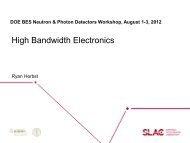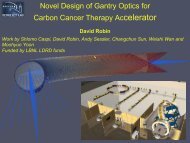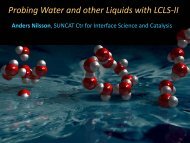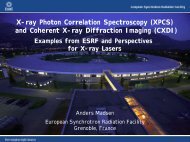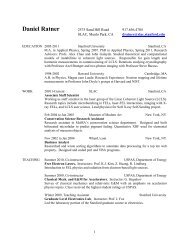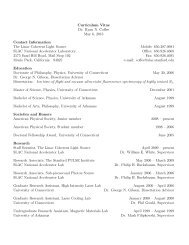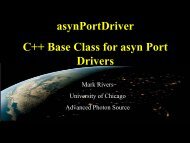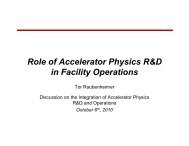SXR Technical Design Report - Stanford University
SXR Technical Design Report - Stanford University
SXR Technical Design Report - Stanford University
Create successful ePaper yourself
Turn your PDF publications into a flip-book with our unique Google optimized e-Paper software.
Dear <strong>SXR</strong> representative,<br />
This letter describes the intention to install, operate and support a fully equipped endstation at the Soft X-<br />
ray for Material Science (<strong>SXR</strong>) beamline at LCLS. The endstation will comply with the requirements<br />
outlined in chapter 5 of the <strong>SXR</strong> <strong>Technical</strong> <strong>Design</strong> <strong>Report</strong> and be avaliable for extended periods of time<br />
(months) per year at the <strong>SXR</strong> beamline for experiments conducted within the experimental group of A.<br />
Nilsson, by other <strong>SXR</strong> collaborators as well as by outside users via LCLS experiment proposals.<br />
The UHV end station, outlined in the figure below, is designed for soft x-ray photoelectron spectroscopy<br />
(PES), x-ray emission spectroscopy (XES) and x-ray adsorption spectroscopy (XAS) of surface and solid<br />
state samples of up to 10mm in diameter having ultra-high vacuum compatibility. The end station is<br />
equipped with an electron spectrometer (R3000, VG-Scienta) for PES, partial electron yield detector for<br />
XAS, and a soft x-ray emission spectrometer housing 2 gratings for photon energies from about 220 eV to<br />
630 eV with a maximum resolving power of about 2000. A horizontally mounted manipulator (VG<br />
Omniax) allows transfer of the sample(s) between the preparation chamber and the analysis chamber.<br />
Sputtering facilities, evaporation sources, mass spectrometer and LEED optics are available in the<br />
preparation chamber. A pulsed gas delivery sustem allows an accurate deposition of gases in a reproducible<br />
manner.<br />
The sample setup, illustrated in the figure below, is optimized for studies of adsorbate systems prepared on<br />
single crystal surfaces. A single crystal is mounted onto a Cu block via a pair of Ta (or W) wires. The Cu<br />
plate is electrically isolated from the sample holder by a sapphire spacer and thus a voltage can be applied.<br />
Temperatures between 30 and 1500 K can be achieved through cooling with liquid N2 (He) and heating<br />
performed by electron bombardment (with or without a biaz). Temperature is measured by thermocouples<br />
spot welded onto the sample or via Ta foil.<br />
This endstation is currently installed and commissioned at BL 13-2 at SSRL, and fully equipped for<br />
experiments at synchrotron radiation sources. To accommodate LCLS experiments a number minor<br />
modifications will be installed. Of particular importance is the integration of fast cameras with the electron<br />
spectrometer and x-ray emission spectrometer. Since both of these instruments have a similar detection<br />
system (MCP + phoshour plate and a camera mounted on the outside of vacuum), we intend to use the<br />
same solution for both spectrometers.<br />
30



